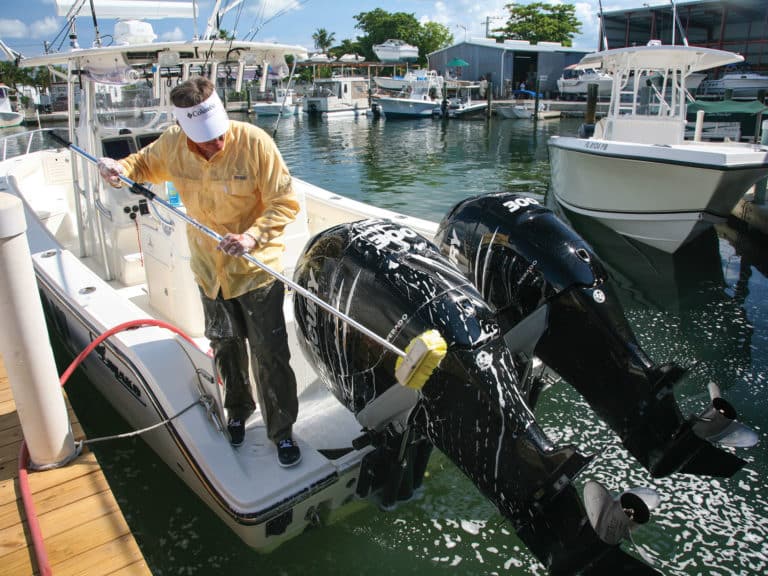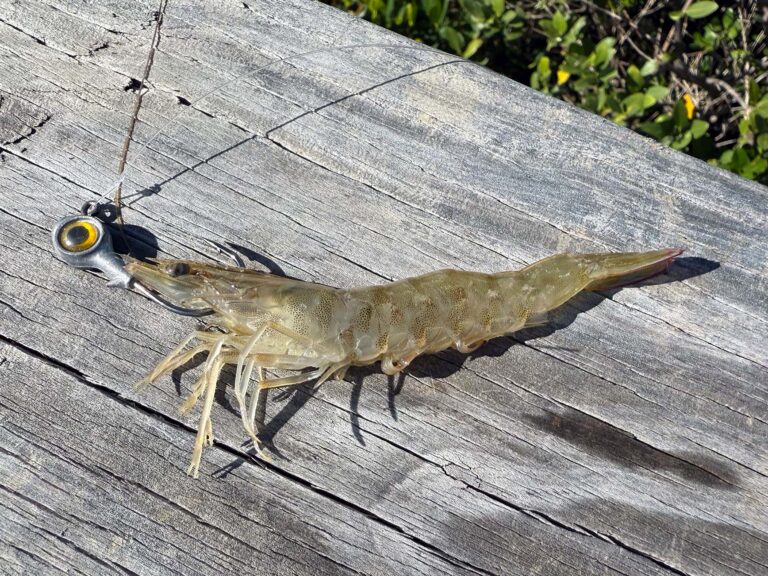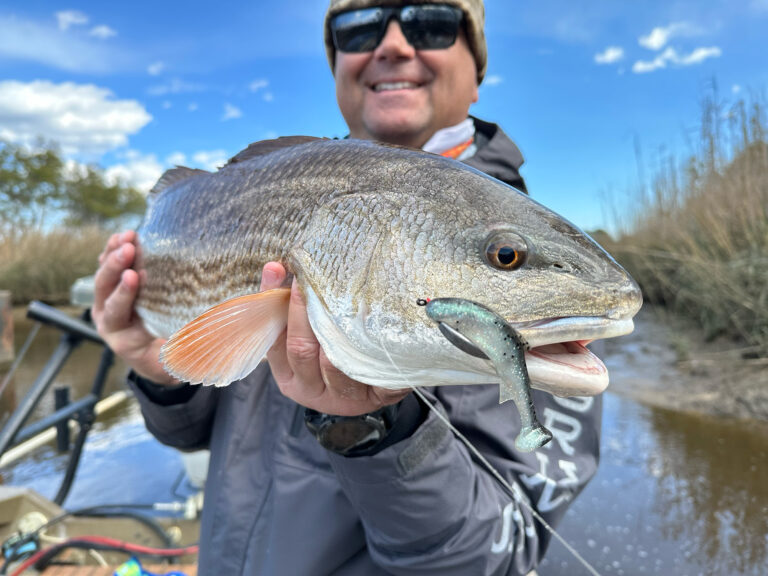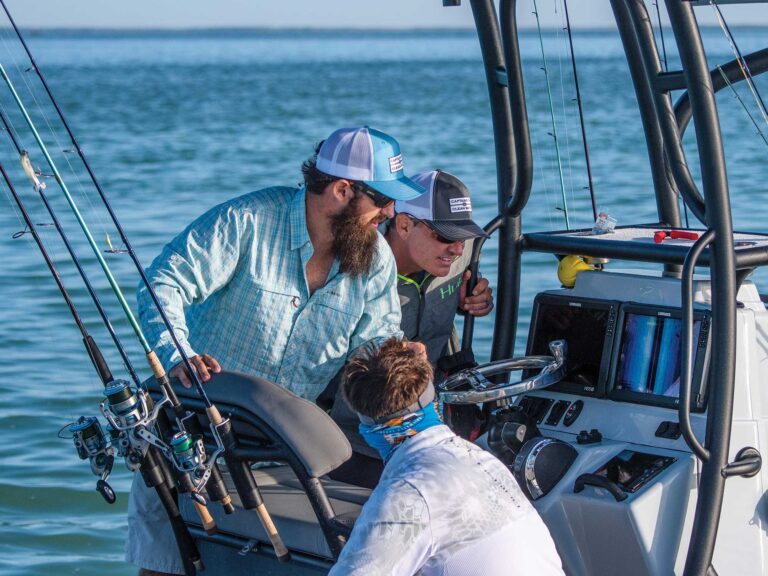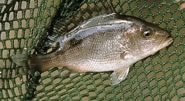
| Lab-produced red snapper such as this may give Gulf stocks a leg up. |
The recovery of red snapper stocks in the Gulf of Mexico – and possibly worldwide – may occur much sooner than previously predicted, thanks to a small group of scientists at the Claude Peteet Mariculture Center in Gulf Shores, Alabama. Scientific breakthroughs in the spawning, feeding and raising of snapper in captivity may result in the center’s producing 100,000 fish per year for restocking and research purposes within the next five years.
“Last year, the center produced 2,000 red snapper, and this year we expect to produce 20,000,” says Vernon Minton, Chief of Marine Resources for Alabama’s Department of Conservation. Helping the center to achieve those numbers is a new salt water pipeline, built with the help of federal funds, running from the Gulf of Mexico to the facility, a distance of approximately five miles. “With this new, unlimited supply of salt water, we expect our production of red snapper to jump tenfold this year,” says Minton. “In the past we’ve had to truck salt water to the center, which made for a very limited supply.
“We’ve proven that we can spawn and grow red snapper in captivity and release them successfully in the wild. A good percentage of these snapper will stay on the reefs where they’re stocked.”
Please Pass the Fry
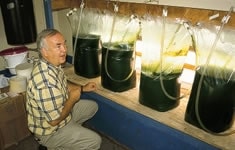
Dr. Ron Phelps of Auburn University looks over the copepods the lab grows to feed its juvenile snapper. More copepods are grown in ponds outside the facility.|
Snapper are about 1/12-inch long when they hatch. At this stage they are called “larvae,” and must have food to eat within the first three days. Perhaps the biggest breakthrough in the snapper-farming program came when Dr. Ron Phelps, a fisheries scientist at Alabama’s Auburn University, and his team were able to keep the snapper larvae alive past three days.
“Copepods are the food source that snapper need once they hatch,” Phelps says. “These small crustaceans, which are basically baby zooplankton, are the most abundant marine animals in the Gulf. We had to learn how to raise the copepods and produce them in the size and number that the snapper could eat when they first hatched. Then we had to learn how to grow the copepods in an outside pond, catch them and put them in the same tank as the larvae. We needed ten to 20 million copepods per day to feed one to two million baby snapper.”
When the researchers first placed the copepods in the snapper tanks, a large percentage of the plankton died due to differing salinity levels. However, with the new pipeline bringing fresh seawater to the Mariculture Center, scientists can raise the copepods and snapper in water of the same salinity. This allows the baby snapper to be placed in the same ponds as the copepods, instead of having to bring the copepods to the snapper. With a more abundant supply of copepods available, and by later training the snapper to eat commercially prepared fish food, scientists expect a higher rate of survival.
Unfortunately, trying to raise wild animals in captivity can be daunting. “Fish science isn’t perfect,” says Phelps. “Sometimes, for an unknown reason, all of the snapper that are spawned die.”
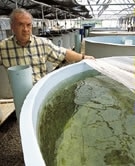
Phelps shows off a holding tank containing tiny snapper.|
In the past, biologists with Alabama’s Marine Resources Division (AMRD) have initiated spawning in captive snapper through hormonal injections, a technique that had its limitations. “One of the problems we had with chemically inducing the spawn,” Minton explains, “is that we had a very narrow window in which to catch the snapper in the wild and get them to spawn. May and June are our best months, and sometimes July. During the two prime months, the size of our facility only allowed for four or five spawns. We had to catch the fish, induce them to spawn, then work with the eggs – a process that took about ten days. So in the past we haven’t been able to get the number of (larval) fish we needed for a major restocking effort.”
To solve this problem, a group of fisheries scientists from Auburn University, headed by Dr. Phelps and including David Maus, who has 20 years of experience in the commercial production of redfish and spotted seatrout, came to the Mariculture Center and developed artificial habitats for the snapper. This allowed them to keep the adult “broodstock” snapper on-hand throughout the year. More importantly, by controlling water temperature and photoperiods, the scientists can trigger spawning at times when survival of the eggs and larvae are greatest. In the future, the technique may be used to induce spawning twice a year, effectively doubling productivity.
“To cause the red snapper to spawn every six months instead of once a year, you have to be able to control the photoperiods, the temperature, and the water quality, because without good water quality the fish become stressed,” Maus explains. “If you can keep the fish from being stressed, they’ll have more energy to put into growth and reproduction.”
The four 1,000-gallon tanks that Maus and his cohorts designed and built each hold four to five adult snapper. They are six feet deep, 12 feet in diameter, and equipped with a water-circulation pump, a biofiltration system, and a heat pump for temperature control. A lighting system inside the tanks simulates sunrise and sunset, as well as moon phase. Each tank has a hood over it to keep out ambient light.
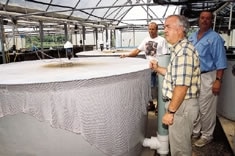
David Maus, Phelps and Vernon Minton oversee the snapper-spawning program at the Claude Peteet Mariculture Center in Gulf Shores, Alabama.|
The habitat tanks not only allow the scientists to induce spawning on demand, they allow the snapper to produce eggs that have a much higher survival rate than those produced through chemical inducement. Once the snapper larvae hatch, they are removed from the tanks and transferred to the copepod ponds, where they grow to a size suitable for release in the wild. (Sometimes the baby snapper are kept in tanks when conditions in the copepod ponds aren’t suitable.) Meanwhile, the adult snapper remain in the habitat tanks to spawn again. Currently, spawning is being triggered once a year to coincide with periods of optimal water temperature and copepod productivity, but bi-annual spawns may be possible in the future.
“Problem” Snapper
But just because the snapper appear more comfortable in the habitat tanks doesn’t ensure success. “One of the problems we have encountered is that not all snapper are compatible or have the same ‘personalities,'” Minton explains. “Scientists have to make sure that the group’s dynamic in the artificial habitat is conducive to a successful spawn. If one snapper doesn’t get along with the others, we usually remove it. Maus, with his extensive background in commercial fish hatcheries, is trained to observe fish behavior and make sure that all the fish get along with each other. He says that he can tell which snapper are ‘happy,’ and has learned that happy snapper are much more likely to spawn successfully than unhappy snapper.”
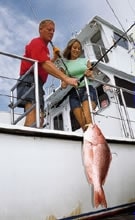
One goal of the mariculture program is to produce enough snapper to support a year-round red snapper fishery in the Gulf of Mexico.|
Minton and his team hope to use the knowledge they’ve gleaned from spawning and rearing snapper in 1,000-gallon tanks to achieve the same results in salt water ponds. If the scientists can raise fingerling snapper in the laboratory, place them in salt water ponds, feed them artificially and grow them to a size that will allow them to survive in the wild, they can speed the recovery of snapper stocks dramatically.
According to Minton, the researchers monitoring the released fish hope to find out whether the snapper stay on the reefs where they are released, where they go if they leave the reef, how fast they grow, whether or not they spawn in the wild and how long they live. If the research at the Mariculture Center continues at the present rate, scientists will be able to produce four- to six-inch snapper for restocking within one year. The young snapper will be marked prior to release to help scientists and anglers identify them.
“Our research indicates that triggerfish, which share the reefs with snapper, will eat the traditional plastic tags placed on the side of the fish,” Minton says. “Also, the introduction of those tags is so traumatic that quite a few small snapper die from the tagging process. Everyone has invested too much in this program to lose fish because of tagging.
“Therefore, we’re considering using a dye that can be injected into the snapper’s cheek and will let scientists and the public easily identify the hatchery fish when they’re caught. This also will allow divers to identify the snapper easily while they’re monitoring the fish’s growth and movement on the reefs.”
The AMRD will ask anglers to notify the department when and where they catch a marked snapper, how much the snapper weighs and the general condition of the fish. This new marking system may begin next year. In the meantime, Salt Water Sportsman will keep you updated on the restocking program at the Claude Peteet Mariculture Center and the new information this team of dedicated scientists has learned. To learn more about this exciting program, contact the Center at (251) 968-7576; www.dcnr.state.al.us/mr/index.html.
February 2004





